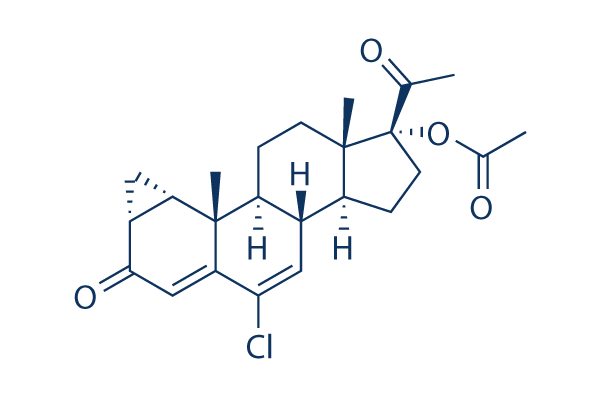CAS Number 2098-66-0 ChemSpider 4447594 CAS ID 2098-66-0 | ATC code None PubChem CID 5284537 Molar mass 374.901 g/mol | |
 | ||
Synonyms SH-80881; SH-881; NSC-758636; 6-Chloro-17α-hydroxy-1α,2α-methylenepregna-4,6-diene-3,20-dione | ||
Cyproterone meaning
Cyproterone (INN) (developmental code names SH-80881, SH-881), also known as 1,2α-methylene-6-chloro-δ6-17α-hydroxyprogesterone is a steroidal, pure antiandrogen that was studied in the mid to late 1960s and early 1970s but was never marketed for medical use. It is the free alcohol or non-17α-acetylated analogue of cyproterone acetate (CPA), an antiandrogen, progestin, and antigonadotropin that was introduced instead and is widely used clinically. Along with benorterone, BOMT, and flutamide, cyproterone was one of the first pure antiandrogens to be developed.
Contents

It is important to clarify that the term cyproterone is often used as a synonym for cyproterone acetate, and when the term occurs, what is usually being referred to is, confusingly, CPA and not actually cyproterone.

Antiandrogen

Like CPA, cyproterone is a potent antiandrogen. However, it has approximately three-fold lower potency as an antagonist of the androgen receptor (AR) relative to CPA. Similarly to CPA, cyproterone is actually a weak partial agonist of the AR, and hence has the potential for both antiandrogenic and androgenic activity in some contexts. Unlike CPA (which is an extremely potent progestogen), cyproterone is a pure antiandrogen and is virtually devoid of progestogenic activity. As such, it is not an antigonadotropin, and is actually progonadotropic in males, increasing gonadotropin and testosterone levels due to inhibition of AR-mediated negative feedback on the hypothalamic-pituitary-gonadal axis.

Due to its progonadotropic effects in males, unlike CPA, cyproterone has been found, in male rodents, to increase testicular weight, increase the total number of type A spermatogonia, increase the total number of Sertoli cells, hyperstimulate the Leydig cells, and to have almost no effect on spermatogenesis. Conversely, it has also been reported for male rodents that spermiogenesis is inhibited and that accessory sexual gland weights (e.g., prostate gland, seminal vesicles) and fertility were markedly reduced, although with rapid recovery from the changes upon cessation of treatment. In any case, the drug is said to not be an effective antispermatogenic agent, whereas CPA is effective. Also unlike CPA, due to its lack of progestogenic and antigonadotropic activity, cyproterone does not suppress ovulation in women.
Other actions
Both CPA and, to a smaller extent, cyproterone possess some weak glucocorticoid activity and suppress adrenal gland and spleen weight in animals, with CPA having about one-fifth the potency of prednisone in mice. Conversely, unlike CPA, cyproterone shows no affinity for opioid receptors. Also unlike CPA, cyproterone seems to show some inhibition of 17β-hydroxysteroid dehydrogenase and 5α-reductase in vitro.
Clinical studies
In clinical studies, cyproterone was found to be far less potent and effective as an antiandrogen relative to CPA, likely in significant part due to its lack of concomitant antigonadotropic action. Cyproterone was studied as a treatment for precocious puberty by Bierich (1970, 1971), but no significant improvement was observed. In men, 100 mg/day cyproterone proved to be rather ineffective in treating acne, which was hypothesized to be related to its progonadotropic effects in males and counteraction of its antiandrogen activity. In women however, in whom the drug has no progonadotropic activity, 100–200 mg/day oral cyproterone was effective in reducing sebum production in all patients as early as 2–4 weeks following the start of treatment. In contrast, topical cyproterone was far less effective and barely outperformed placebo. In addition, another study showed disappointing results with 100 mg/day cyproterone for reducing sebum production in women with hyperandrogenism. Similarly, the drug showed disappointing results in the treatment of hirsutism, with a distinct hair reduction occurring in only a limited percentage of cases. In the same study, the reduction of acne was better, but clearly inferior to that produced by CPA, and only the improvement in seborrhea was regarded as satisfactory. The addition of an oral contraceptive to cyproterone resulted in a somewhat better improvement in acne and seborrhea relative to cyproterone alone. According to Jacobs (1979), “[cyproterone] proved to be without clinical value for reasons that cannot be discussed here.” In any case, cyproterone has been well-tolerated by patients in dosages of up to 300 mg/day.
History
Cyproterone, along with CPA, was first patented in 1962, with subsequent patents in 1963 and 1965.
